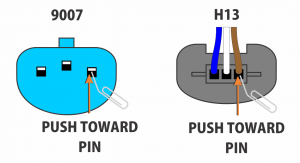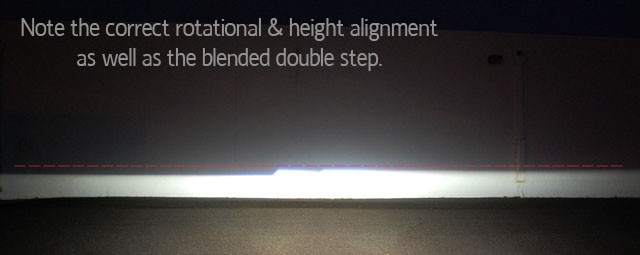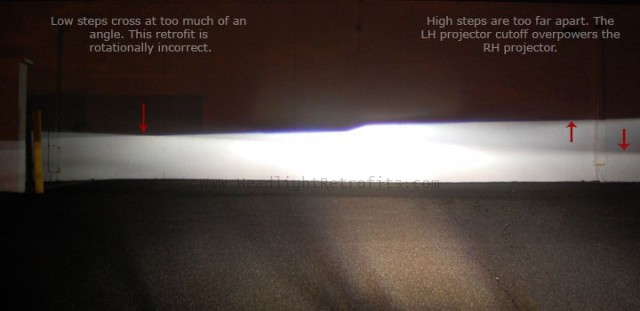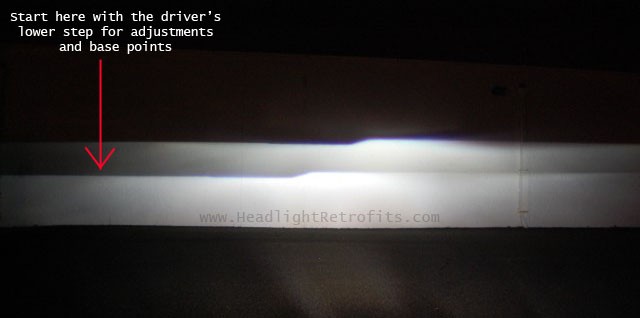Thanks again for choosing SuperDutyHeadlights.com
We appreciate your business and look forward to any post-purchase support, questions or concerns you may have regarding your newly fabricated headlight system.
Please share any installed or on vehicle pictures you may have. Your submitted pictures are always a great addition to our Examples Gallery.
STOP – READ DIRECTLY BELOW FIRST
Please verify your box contents and read the installation guides below – first. This section also contains almost any/all troubleshooting issues that can come up – please refer to them before contacting us.
Support
Wiring Harness Installation
1) The diagram to the right is the standard use and proper installation of the Morimoto MotoControl Bi-Xenon harness.
2) The 12V+ Power lead of the harness needs to go directly to the pos itive terminal of your vehicle battery. NOTE: If you have a battery not easily accessible from the front (mounted in trunk or on firewall), you should have a 12V+ jumper terminal in the engine bay you can run this connection to.
itive terminal of your vehicle battery. NOTE: If you have a battery not easily accessible from the front (mounted in trunk or on firewall), you should have a 12V+ jumper terminal in the engine bay you can run this connection to.
3) Ensure you have the grounds to bare metal and not a plastic surface.
metal and not a plastic surface.
4) The harness input plugs into the original headlight connector on the side closer to the battery. The headlight connector on the side further from the battery will not be used and can be capped off.  NOTE: As this input connector cannot be waterproof, we recommend adding dielectric grease to all pins to minimize likelihood of any corrosion of these pins.
NOTE: As this input connector cannot be waterproof, we recommend adding dielectric grease to all pins to minimize likelihood of any corrosion of these pins.
5) The MotoControl box should be installed on the vehicle by hanging it from the indicated mounting hole.  This minimizes the chance of water entering the box which may cause failure.
This minimizes the chance of water entering the box which may cause failure.
6) If you have the harness working but not in both modes (low and high), you may need to swap some pins on the input of the harness.  This can be fixed easily by de-pinning and swapping the wires around on the input of the harness using a tiny flathead screwdriver or unbent paper clip as shown.
This can be fixed easily by de-pinning and swapping the wires around on the input of the harness using a tiny flathead screwdriver or unbent paper clip as shown.
Ballast Installation
1) As part of the installation process, ensure all connections “click” together with their respective plugs to maintain water-resistant properties for the connection.  While the ballast does not need to be grounded, we recommend it. NOTE: We do not guarantee proper function without the use of an approved Morimoto wire harness.
While the ballast does not need to be grounded, we recommend it. NOTE: We do not guarantee proper function without the use of an approved Morimoto wire harness.
2) As part of the installation process, ensure the connection between the igniter and ballast box are fully seated, with the clip holding the connection tight. The igniter must be snug in the ballast output to ensure no damage results.
The igniter must be snug in the ballast output to ensure no damage results.
3) We recommend mounting the ballasts in the indicated directions to ensure no water penetration into the connectors.  The connections cannot exit at the top as that causes water to pool up inside them.
The connections cannot exit at the top as that causes water to pool up inside them.
4) D2S Ballasts:: To ensure you do not damage the D2S bulb upon installation, we recommend to push the head of the ballast until it is fully seated against the bulb. Then turn the D2S head to lock it onto the bulb. NOTE be mindful that the tabs on the side of the bulbs must be fully seated in the ballast head prior to turning the ballast head to lock it. They are fragile and must be used with care. If you hear a “zapping” noise, the ballast head is not fully seated on the bulb and may cause permanent damage / fire.
NOTE be mindful that the tabs on the side of the bulbs must be fully seated in the ballast head prior to turning the ballast head to lock it. They are fragile and must be used with care. If you hear a “zapping” noise, the ballast head is not fully seated on the bulb and may cause permanent damage / fire.
5) AMP Ballasts :: Ensure all male/female connections are snug and clicked together. If you hear a zapping noise, check the connections to ensure they are all fully seated.
Aiming & Alignments
Alignment, Adjustment & Tweaks:
It should be noted that proper patience, time and surroundings should be available to adjust your lights. It may take a few trial and error adjustments to get them just right and to your personal liking.
All the alignments on your housings can be done through the factory adjustment knobs. If your output is rotationally off there are notes regarding this below, however, please contact us for special assistance as this may indicate an underlying issue.
DO NOT OVER ADJUST ALIGNMENT KNOBS – This can potentially cause damage to your new headlight system. Please contact us should your adjusters not function properly or feel too snug.
- -First, find a good level ground area to park your vehicle on that has an adjacent broad-sided building. Park approximately 30 feet away & facing the wall.
- -Next, measure the distance from the ground to your projector inside the headlight (let’s use 30 inches as an example).
- -With your headlights turned on, measure the lower portion of the DRIVER cutoff step. The goal is for the cutoff step to be approximately 2 inches lower than your projector measurement. So, in our scenario, 30 inches minus 2 inches gives us 28 inches.
- -Then simply align your PASSENGER projector to the same point as your left one.
- -Road test and adjust slightly up or down as needed.
The general adjustment range is 2-4 inches LOWER than what your projector measures, depending on your personal preferences.

Output Tweaks & Rotation:
This section is a basic explanation of projector output that looks “off”, “bad”, “tweaked” or “incorrect”. There are any number of reasons this could have happened to your new headlight retrofit package and what we’ve seen most often as the culprit is shipping damage. The internal components on our headlight builds are extremely reliable & sturdy with regards to standard vehicle use — however, when rough package handling or an overloaded delivery truck puts unexpected stress on a package, something can go wrong.
Below are a few example images of “off”, “bad”, “tweaked” or “incorrect” projector cutoff output. There may be a simple adjustment you can make to rectify the issue or it may require shipping the headlight back for us to repair.

Output Tweaks & Rotation:
This mini-writeup is intended to help you make any basic rotation/output tweaks as needed with your setup. It should be noted that the headlight housings should NOT be opened, modified or altered in any way to do these steps as this voids our warranty – what we’re explaining here are simply adjustments that can be made. .25mm to .5mm can make a big difference in terms of rotation.
MH1 & D2S v2.0&v3.0 Projectors
These projectors are primarily installed using their threaded in collars. While we snug them up very securely and add epoxy to keep things from vibrating loose, there is still a bit of built in rotation adjustment.
-Step 1: Ensure you have the basic tools needed (screwdrivers, sockets, work gloves & projector adjustment tool).
-Step 2: Projector adjustment tool is ANY properly sized tool/object that fits into the bulb slot opening on the back – for MH1’s this is often a pair of scissors – for D2S v2.0’s & v3.0’s this is often the butt end of a ratchet.
-Step 3: Park your vehicle in a good sized lot facing a level flat wall (approximately 30 feet away), take not of the projector output/rotation.
-Step 4: Remove the bulb from your projector that needs a rotation tweak/adjustment (if both, start on drivers side).
-Step 5: Insert the “projector adjustment tool” as noted above and GENTLY twist in the direction needed – if the RIGHT side is low – twist COUNTER-CLOCKWISE – if the LEFT side is low – twist CLOCKWISE.
-Step 6: Re-install bulb (without touching glass) and test output.
-Step 7: Repeat as needed until projector is level (generally 1-2 tries of GENTLY twisting does the trick).
-Step 8: Repeat procedure on opposing side headlight as/if neeeded.
Please contact us should something about your new setup seem out of place.
Photos below courtesy of HeadlightRetrofits.com
Shipping Damage
If any part of your package, headlights or contents was damaged during shipping – please contact us BEFORE contacting the shipping company. Sometimes filing a claim can take much longer than expected and runs the risk of the shipping carrier potentially collecting the box or boxes for inspection.
If a simple fix is available (whether by us or you), this is often preferable to a full claim investigation.
Please use out support contact form at the bottom of this page and we’ll respond as quickly as possible to help access damage and a solution. Emails are the best method for contacting us.
Parts Missing In Box
Double & Triple check all the contents of your packages to ensure everything was included with your build. This can include (but is not limited to), wiring, ballasts, bulbs, pigtails, plugs, our warranty w/instructions link card and any other specific build items.
It’s important to confirm all items are received so a proper installation can take place.
Please contact us below if you feel something is missing from your packages. Most often something settles at the bottom with packing material.
Lights Won’t Turn On
If your headlights BOTH won’t turn on after completing your installation this could be due to a few different things.
The first thing to check and confirm are ANY & ALL grounds for the system. A radiator bolt is NOT a sufficient ground. We recommend a direct battery or bare chassis ground – as noted in the installation instructions PDF file.
Next – check ANY & ALL fuses related to the headlight system. This includes any fuses built into your vehicle from the factory as well as any on the new harness we supplied (if applicable). Replace as needed.
Last – check all your sockets and connections. Sometimes when connecting two sockets a pin can be pushed out or bent which can cause a lack of electrical contact. Repair by simply pushing back in OR bending into place as needed.
One Light Won’t Turn On
If one side headlight won’t turn on, we recommend following the procedures below :
The first thing to check and confirm are ANY & ALL grounds for the system. A radiator bolt is NOT a sufficient ground. We recommend a direct battery or bare chassis ground – as noted in the installation instructions PDF file.
Next – check ANY & ALL fuses related to the headlight system. This includes any fuses built into your vehicle from the factory as well as any on the new harness we supplied (if applicable). Replace as needed.
Last – check all your sockets and connections. Sometimes when connecting two sockets a pin can be pushed out or bent which can cause a lack of electrical contact. Repair by simply pushing back in OR bending into place as needed.
If none of these sort the issue out – please swap ballasts from side-to-side, to see if the issue follows the ballast OR is specific to that side. If the issue follows the ballast, you may have a defective ballast. If the issue STAYS on that specific side of the vehicle – you likely have a wiring or harness issue.
Please contact us below regarding a faulty ballast.
My Lights Flicker but won’t fully turn on
If your headlights only “flicker” or rapidly pulse but WON’T fully turn on there may be a few underlying issues.
Check all your grounds, connections, socket pins and fuses.
Your vehicle battery may be weak. Try starting the vehicle, allowing it to charge for one minute and then try turning the headlights on again.
You may have the “auto-on” option selected for your headlights. This can sometimes cause a voltage regulation issue going to a newly installed headlight harness, causing the ballasts not to receive full power. We recommend turning the “auto-on” feature OFF.
Is your vehicle canbus equipped or does it have computer controlled headlights? Often times these types of vehicles should have special controllers sent with the headlights to avoid any computer interference or issues. This should be indicated or noted at the time of your build sheet organization (before any work began).
High beams are on instead of low beams
If your high beams are on or activated when your first turn your headlights on (LOW BEAM ONLY) there may be a control wire switched on the harness.
Note: This often refers to vehicles that have a single bulb for both high beam and low beam operation from the factory – such as H4, 9007 or H13.
As a variety of vehicles all use the same bulbs (H4, 9007 or H13) for dual beam operation, their wiring and internal control systems are NOT all the same.
This is a simple fix that takes just a few minutes. The 3 wire control socket that plugs into ONE side of the vehicle simply needs it’s pin positions switched.
Wobbly or Bouncy Output
HID projectors by their very nature have super sharp and clear output. This is almost razor-like on a wall or flat surface.
With properly adjusted and aimed headlights you’ll notice the cutoff steps. These may appear to be slightly bouncy while driving. This is normal due to the fact that the vehicle is also bouncing/moving/vibrating during normal driving conditions. You’re simply not used to seeing the sharp light output on the road – this does take a bit of getting used.
If one headlight (or potentially both) seem to be extra bouncy, not moving with the rhythm of the vehicle or very “jerky” in motion there may be internal damage to the lights. This can sometimes occur from shipping damage. Please contact us if you feel shipping damage occurred.
My projector rotation isn’t level
If the light output is off by rotation or incorrect, there are a few adjustment or “tweak” methods available to help correct this. While there are a number of variables that can affect this – generally this can be corrected as most often an extremely small movement makes a big difference – even just .25mm to .5mm.
Please see our FAQ in this section on AIMING & ALIGNMENT
Output is TOO LOW
If the light output is too low, you should have enough adjustment range from the OEM adjustment knobs on the lights to raise them. Generally just a few millimeters makes a big difference on the road.
Please see our FAQ in this section on AIMING & ALIGNMENTS
If your adjustment knob is is NOT making any difference in the light output – please refer to our FAQ in this section PIVOT POINT GUTS RESET
Output is TOO HIGH
If the light output is too high, you should have enough adjustment range from the OEM adjustment knobs on the lights to lower them. Generally just a few millimeters makes a big difference on the road.
Please see our FAQ in this section on AIMING & ALIGNMENTS
If your adjustment knob is is NOT making any difference in the light output – please refer to our FAQ in this section PIVOT POINT GUTS RESET
One headlight is fuzzy or blurred
Both your HID projectors have been double tested prior to them being built into your lights.
If the output on one projector is drastically different compared to the other (ie. fuzzy, blurred, severely-bowed or otherwise NOT sharp) this may be due to a bulb seating issue.
If this is a D2S bulb the socket may be pushing against something causing the bulb to mis-align. Check the socket and re-install – re-seat the bulb as needed.
The same can be checked for H1 bulbs in an MH1 projector system. Remove the bulb and re-seat then test the output.
Both Lights Flicker Intermittently
If your headlights “flicker” or rapidly pulse intermittently, there may be a few underlying issues.
Check all your grounds, connections, socket pins and fuses first. There may be a loose connection or plug somewhere in the system.
Your vehicle battery may be weak. Try starting the vehicle, allowing it to charge for one minute and then try turning the headlights on again.
You may have the “auto-on” option selected for your headlights. This can sometimes cause a voltage regulation issue going to a newly installed headlight harness, causing the ballasts not to receive full power. We recommend turning the “auto-on” feature OFF.
Is your vehicle canbus equipped or does it have computer controlled headlights? Often times these types of vehicles should have special controllers sent with the headlights to avoid any computer interference or issues. This should be indicated or noted at the time of your build sheet organization (before any work began).
Both Headlights Don’t Start All The Time
If your headlights “flicker” or rapidly pulse intermittently, there may be a few underlying issues.
Check all your grounds, connections, socket pins and fuses first. There may be a loose connection or plug somewhere in the system.
You may have the “auto-on” option selected for your headlights. This can sometimes cause a voltage regulation issue going to a newly installed headlight harness, causing the ballasts not to receive full power. We recommend turning the “auto-on” feature OFF.
Is your vehicle canbus equipped or does it have computer controlled headlights? Often times these types of vehicles should have special controllers sent with the headlights to avoid any computer interference or issues. This should be indicated or noted at the time of your build sheet organization (before any work began).
High Beams Don’t Work
If you’re high beams don’t work there may be underlying reasons.
First – which type of system do you have? Did the vehicle have ONE bulb for both low and high beam operation OR is it a split system, meaning there was ONE bulb for low beam and ONE bulb for high beam?
With a SINGLE bulb for high and low beam, a new wiring harness was included with your build. This controls the output and keeps the HID bulb on while activating the high beam solenoid within the projectors. If your high beams do NOT work within this system, check all connections, grounds and fuses. If you are still only getting low beam operation, disconnect the high beam pigtails on ONE side and test the pins with DIRECT battery power (this can be done with alligator clips to the battery OR a 9 volt battery).
If the high beam solenoid clicks and makes it’s noise – you likely have a connection problem to the main harness (a pin may have pushed out or is bent).
If your system is the split system with ONE bulb for low and ONE bulb for high beams – check to see that the new HID projector high beam pigtail is connected or tied into the stock halogen high beam bulb with a splitter.
My Ballasts are Buzzing
Most HID ballasts make some sort of noise or “buzzing” while operating – it’s simply the sound of electricity being converted and applied to your new HID bulbs.
Some HID ballasts will have noticeable noise during startup (the first 30-60 seconds) and will quiet down a bit. Some will remain noisy for the entire duration of your headlights being on.
This is perfectly normal, not harmful in any way and is not heard during normal driving conditions.
If you have any LOUD arcing sound, this may indicate a problem. This is extremely rare though.
Pivot Points OR Guts Mounting Reset
If your headlights have the symptoms of “loose internal guts” (as described in a few of the other troubleshooting topics on this page), the procedures here may help to diagnose and/or solve this.
The projectors in your HID system sit inside the headlights in what we refer to as “guts”. These guts are held in place by three pivot points.
Sometimes during shipping a package can be handled roughly – it is unfortunately but it does happen. This can cause the guts to pop off one or more of their pivot points – sometimes with additional damage, but most often it’s simply just a pop-off issue.
To rectify this you can gently grab the back of the projector and give it a gently “wiggle”. If it seems to move freely or more than 1-2mm there may be a mounting point internally that has popped off. Simply grab the projector and pull backwards, toward the back of the headlight housing to “pop” it back in place. You’ll hear or feel a small click. Do NOT make sudden or jerking motions – a slow even pressure often pops it back in.
This can explain a wobbly headlight output, poor adjustment capability, rotation issue with the output, or having a light that’s aimed too low or high.
Moisture Issue
What if my headlights are leaking? What if I see fog in them? What if there is a lot of water in them?
With ANY custom headlight build there is the potential risk of them having a moisture issue. This isn’t a common occurrence, but can happen as with anything custom built – there is a chance of an issue arising.
If this should happen – first determine what the severity of the moisture is. A very light fogging, “waterfalls” or a puddle of water?
For fogging or VERY light fogging, we recommend one of two methods to fix this. The first (if you live in a relatively dry climate) is to pop a back cap off of the housing and park the vehicle with the headlight in direct sunlight for a few hours. This often drys the light out and solves the issue. The next method which is slightly quicker is to remove a back cap and aim a hairdryer on LOW at the opening for approximately 30 minutes(or until the light is completely dried out). These are both highly effective.
If you are experiencing a “waterfall” effect or a puddle of water in the light you may have a seal or cap issue. To remedy this on your own (should you choose to do so), we recommend taking the light off the vehicle. Drain as much water as possible and then remove a any & all back caps from the housing. Aim a hairdryer on low at a backside opening and allow the light to dry for approximately 30 minutes. Then, heat in your oven on LOW (170 degrees or lower if possible) for approximately 20 minutes. The BACK of the headlight housing should sit on the oven shelf – NOT the front lens portion. Once removed from the oven, squeeze the edges of the light housing at the seam. Allow to cool, re-install on the vehicle and watch for moisture over the next 7 days.
If you’re not comfortable with any of these procedures please contact us below and we’ll make arrangements with you for the repair of your lights. There may be associated costs with this.


